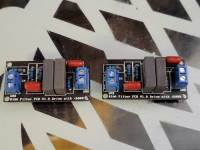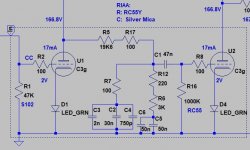Yes. The D3As are matched. What I'm interested in is getting the 0.1uf and the 0.033uf caps close to the specified value while using a styroflex dilectric . Really, any dielectric to be honest.
What footprint? I use 10mm for 100nF, and 15mm for 33nF (and 1000pF) and I could send you some matched sets if you want... I even have completes... Dielectric metalized polypropylene or in the case of 1000pF it could be silver mica...
By those values, you're using the same filter values as I am, probably.
For me,
R1= 22k
R2= 100k || 3k3
C1= 100nF
C2= 33nF || 1000pF

By those values, you're using the same filter values as I am, probably.
For me,
R1= 22k
R2= 100k || 3k3
C1= 100nF
C2= 33nF || 1000pF
Attachments
Last edited:
What cap voltage is needed ?
But the silver mica if some voltage is needed, there is also the styren tin foil from LCR radial and axial fscr something serie at Farnel..1 or 2 % exist but do no remember the voltage rating.
Mundorf fkp2 are excelent too in 5mm pitch...same voltage limit ?
I use the LCR as i/v decoupling...pretty good
But the silver mica if some voltage is needed, there is also the styren tin foil from LCR radial and axial fscr something serie at Farnel..1 or 2 % exist but do no remember the voltage rating.
Mundorf fkp2 are excelent too in 5mm pitch...same voltage limit ?
I use the LCR as i/v decoupling...pretty good
Last edited:
Parts made with Unobtanium are hardly justified when tubes in the circuit may be +/- 20%.
A couple of stages of that will make a difference.
Which version of that amp will measure best? Which version will sound best?
Will any of them win in a double blind test?
All comes down to which kind of distortion do we like best. A personal choice,
Long as it glows in the dark!🙂
A couple of stages of that will make a difference.
Which version of that amp will measure best? Which version will sound best?
Will any of them win in a double blind test?
All comes down to which kind of distortion do we like best. A personal choice,
Long as it glows in the dark!🙂
I don't really care about the footprint as this will be a point to point build. I just care about accuracy of the parts.
No. But I am not posting the schematic as the conversation will focus on the parts choices of the designer rather than what I am interested in.Is this the Sy phone stage ?
Oh i do not care...was just curiosity. My digistal sys is better than any LP I just remembered the white dog having published a good one with 3da.No. But I am not posting the schematic as the conversation will focus on the parts choices of the designer rather than what I am interested in.
Anyway hope that it helped. Good luck.
Not criticizing you, at all, but the "designer" who wants you to spend needlessly. 🙂That's why I'm asking the questions! Let's not criticize what no one has done.
Still looking for information. These are the film caps with the tightest tolerances I could find. Could not find polystyrene, which someone recommended, in the proper specs 0.1uf and 0.033uf.
Capacitor
Will an inexpensive capacitor tester do the job if trying to match a pair to the specifications and to each other?
Component Tester
Thanks once again.
Capacitor
Will an inexpensive capacitor tester do the job if trying to match a pair to the specifications and to each other?
Component Tester
Thanks once again.
As I understand it, use of polystyrene as a dielectric in film capacitors is being phased out in favor of polypropylene. That's why it's getting difficult to find polystyrene film-and-foil caps. They used to be really common as surplus. I used to be able to find 630V rated ones. I don't know where to find those now.
What's wrong with polypropylene film-and-foil like the Wima FKP series? ERO and Kemet also make that type of capacitor, and the Vishay/Sprague 716P orange drop caps are available.
https://www.mouser.com/c/passive-components/capacitors/film-capacitors/?capacitance=0.033 uF|~0.1 uF&dielectric=Polypropylene (PP)&lead style=Crimped|~Inside Bend~~Straight&number of pins=2 Pin&termination style=Axial|~Radial&tolerance=2 %~~5 %&voltage rating dc=250 VDC|~400 VDC|~600 VDC|~630 VDC&instock=y&rp=passive-components/capacitors/film-capacitors|~Lead Style|~Tolerance
Are the inexpensive LC meters really that inaccurate?
What's wrong with polypropylene film-and-foil like the Wima FKP series? ERO and Kemet also make that type of capacitor, and the Vishay/Sprague 716P orange drop caps are available.
https://www.mouser.com/c/passive-components/capacitors/film-capacitors/?capacitance=0.033 uF|~0.1 uF&dielectric=Polypropylene (PP)&lead style=Crimped|~Inside Bend~~Straight&number of pins=2 Pin&termination style=Axial|~Radial&tolerance=2 %~~5 %&voltage rating dc=250 VDC|~400 VDC|~600 VDC|~630 VDC&instock=y&rp=passive-components/capacitors/film-capacitors|~Lead Style|~Tolerance
Are the inexpensive LC meters really that inaccurate?
There is nothing inherently wrong with the type you linked to, I was just trying to find something more "interesting" than those. I did buy the 3% Panasonics though.
I don't know anything about the accuracy/quality of inexpensive LC testers - that's why I asked the question.
Thanks for your help!
I don't know anything about the accuracy/quality of inexpensive LC testers - that's why I asked the question.
Thanks for your help!
It was my impression Styroflex capped out at 250V rating.Having trouble finding a styroflex cap 250V or more in 0.1uf and 0.033uf. Even harder to find them in better than 10% tolerance. Any specific suggestions?
It's relatively easy to get PP or Polystyrene film in those values, but voltage choice and precsision are the problems.
Most of my polystyrene foam capacitors are 160V rated. I've never seen any above 250V. And never any 1% tolerance over 4700pF and 160V.
When I was making an active filter, I sought out the most accurate capacitors for the values.
There was only one acceptable range of +/-1% PP films, (in 100nF and 10nF) and these were 63V/100V 5mm pitch box films.
I ended using a messy looking parallel combo of styroflex to trim the capacitors to the values I wanted (some 160V 2.5% and also 1%)
I love these capacitors, and there is nothing like them, for certain applications - I'm not sure a 250V part would be any more useful to me than a 160V part though. And there is some...romance in using good vintage parts (but not for the sake of being vintage)
The cheap TC1 testers are pretty good.
They aren't much cop at ESR measurement, so will indicate 0 Ohms for probably anything under 0.1 Ohms, but they measure C very accurately at whatever excitation voltage it uses.
Measurement of L is not as good.
Measurement of hfe etc is limited in the same way as DMM meters but is consistent and repeatable.
A bargain and I'm glad I bought one.
Last edited:
Hi Wintermute, follow Zung's advice and get the component tester. I still recommend the REL RT polystyrene caps for my RIAA stages. Everything I have designed from Vendetta, Constellation, Parasound, and others always use REL RT caps in the RIAA. 1% matching is a problem to purchase, but you can buy a few extra, and hope for a good 2 channel match. Also you can balance the cap values by adding a small polystyrene cap in parallel to one of the caps to get closer in tolerance.
Ripple current rating is 2.8A so you should be good up to that current in a power supply.
All other specs look pretty normal, nothing specifically bad or wrong.
A 13 a dozen cap, can't go wrong with it.
Jan
All other specs look pretty normal, nothing specifically bad or wrong.
A 13 a dozen cap, can't go wrong with it.
Jan
There are also the LCR tin foil polystyren as the REL alternative, exist both radial and axial with 2% precission, do not remember if they also have a 1% though.
They aren't bad caps. It depends on the price.Can anyone tell how good or Bad Samyoung capacitors are?
Here is the Datasheet and pictures of capacitors in questionView attachment 1140530View attachment 1140531
You can get their NXH series (10000H, 105°C) for under 1$ each as singles... https://www.lcsc.com/product-detail...ctronics-NXH35VB3300M16-31-5-LO_C2835685.html
- Home
- Amplifiers
- Tubes / Valves
- Capacitor Recommendations

